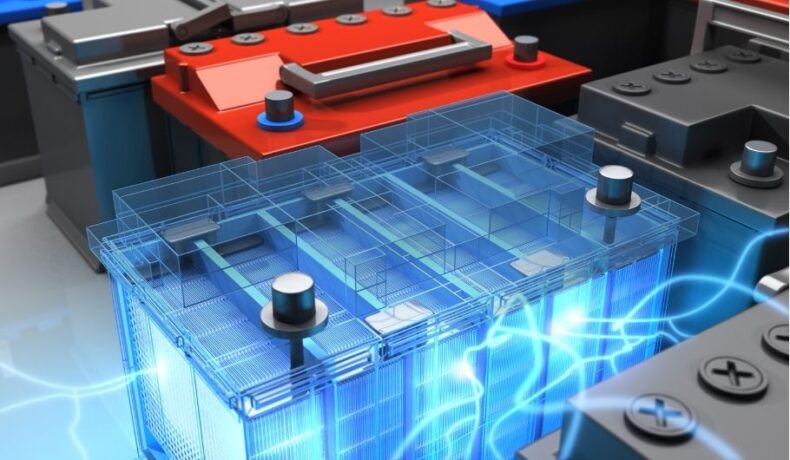A 100Ah battery is a standard off-the-shelf product you can buy at any physical or online store. They are usually rated at either 12V or 24V, which indicates the battery voltage.
For the newbies out there, the battery rating “Ah” stands for “ampere-hours,” meaning you can draw 1 ampere (the unit of electric current) from the battery for 100 hours. This concept holds for other ampere values as long as the multiplication process results in 100Ah. For example, you can draw two amps for 50 hours, four amps for 25 hours.
Another way to express “Ah” is by converting the 1 ampere into watts. We can do this through the power formula.
In electricity, the formula for power is:
Power = Voltage x current
Following this, the power stored in a 12V, 100Ah battery will be 12V x 100Ah = 1200 Watt-hour (Wh) or 1.2 kilowatt-hours (kWh).
Don’t worry. We are not showing off. Converting Ah to Wh will come in handy later in our discussion.
Table of Contents
What is a 100Ah Battery?
Whether you’re running a simple solar setup or plan on charging your second battery via a battery isolator, we’ve found that 100-amp hours gives the average van dweller an ideal combination of energy and price.
It’s generally sufficient to run LED lights, charge cell phones/tablets, and run small accessories via an inverter.
However, if you need to run large appliances consistently, like a 12V fridge or a small air conditioner, you may consider an even larger battery or multiple runs “in parallel.”
Should I Get a Lead-Acid or Lithium 100Ah Battery?
When deciding whether you should get a lead-acid or lithium-ion 100Ah battery, you must first understand what applications you have in mind.
There are endless ways to utilize energy storage. However, typical 12V 100Ah batteries are usually for running small to medium appliances in RVs, boats, camps, among others.
Others wire 12V 100Ah batteries in parallel to store more energy produced by their off-grid solar panel systems.
Now let’s talk about the first kind of battery technology.
12V 100Ah Lead-acid batteries are the inexpensive choice for adventure-seekers on a budget. They cost around $175-$250. They are also more inclusive when it comes to creating parallel configurations.
By comparison, lithium-ion batteries often have to be the same brand for you to connect them in parallel. This stems from the unique manufacturing methods and configurations of each lithium-ion product.
The lithium-ion battery is the more modern option for people who value portability, efficiency, performance, and toughness. Other advantages of lithium-ion batteries include fast charging, a longer lifespan, and durability.
In addition, lithium-ion RV batteries can retain their state of charge after long periods of inactivity. Most RVs are indeed used during the weekend or at entire, month-long vacations.
Lithium-ion is usually the better choice since RVs, boats, and cars are better off with stronger batteries.
Now, batteries in RVs are usually charged by solar panels through a solar charge controller. However, due to limited space, the solar panel array’s total power rarely exceeds 800W. Therefore, a complementary charging source could be the vehicle’s alternator.
Now, we are not trying to put lead acid under a bad light here. Lead-acid batteries are still commonly used by RV owners. However, they suffer from being overly heavy and low in durability.
Your 100Ah Battery’s Lifespan
Before connecting your 100Ah battery to different appliances, let us first discuss the two essential factors affecting your 100Ah Battery’s lifespan:
- Depth of Discharge; and
- Battery cycle
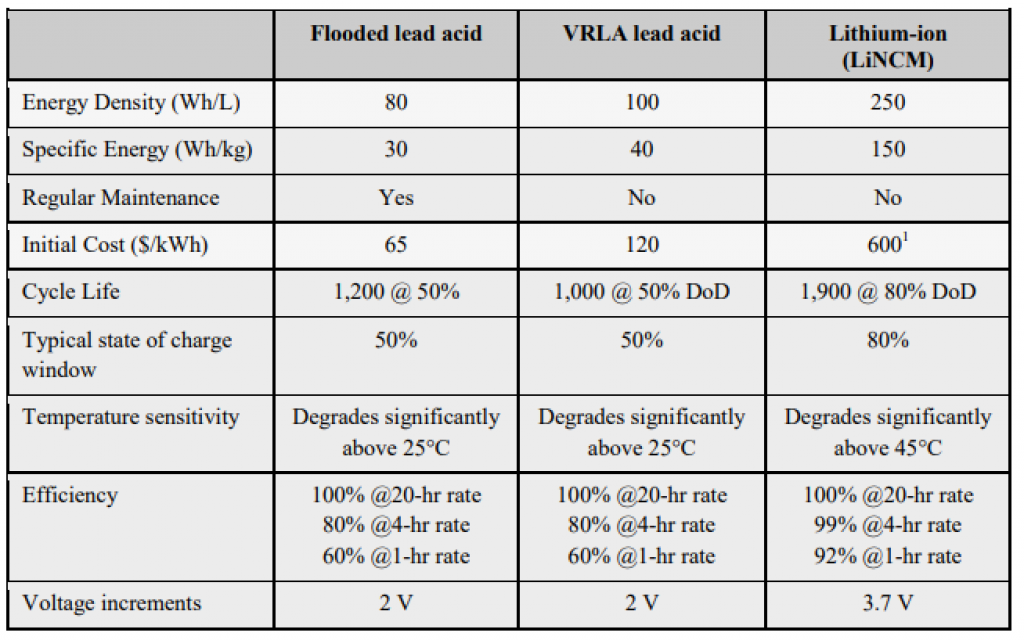
Each battery’s lifespan depends mainly on the amount of stored energy you use in terms of percentage, a.k.a Depth of Discharge (DoD), and how many times you have charged and discharged your 100Ah battery, a.k.a battery cycles.
Before we compare the two batteries in the two categories we mentioned, let’s expound on the concept of DoD and battery cycles a bit further.
Depth of Discharge
DoD can also be described as the percentage of the battery discharged relative to the battery’s full capacity. It is sometimes used with the term State of Charge (SoC), which tells you “how much energy is left in your battery.”

In the figure above, assuming each bar is 25% of battery charge, we can say that the red, brown, yellow, and green icons have a DoD of 75%, 50%, 25%, and 0%, respectively.
This also means that they respectively have 25%, 50%, 75%, and 100% SoC.
For, example, if you use (discharge) your 100Ah battery for 0.5 hour at a current of 50 A, the depth of discharge is 50 * 0.5 * 100% = 25%.
Battery Cycle
On the other hand, a battery cycle is the number of charge/discharge cycles are battery can sustain in its useful life.
Going back to the main topic, both the DoD and the number of charge/discharge cycles vary between lead acid and lithium-ion battery technologies.
Between the two, lithium-ion has better performance in these two battery categories. As you can see on the table, lithium-ion can tolerate a DoD of 80% and still end up with 1,900 battery cycles before it deteriorates.
In contrast, lead acid’s lifespan is more limited regarding DoD and battery cycles. If you want to make your lead acid battery last longer, you must keep the DoD under 50% every time you use it. And even if you accomplish this, you can only expect about 1000-1200 cycles before it deteriorates.
Therefore, you are better off with lithium-ion if you are looking for a 100Ah battery that isn’t restrictive and will give you more battery cycles.
Discharge Rate
Aside from DoD and battery cycle, a parameter that usually flies under the radar for battery performance is discharge rate. In a nutshell, discharge rate performance demonstrates how fast a battery can discharge without affecting its total capacity.
This consideration is arguably essential when choosing between lead acid and lithium-ion. Unlike lithium-ion, lead acid sacrifices available capacity when discharged in short periods. According to a white paper of ALLCELL, a 100Ah VRLA can only provide 80 Ah when discharged within 4 hours.
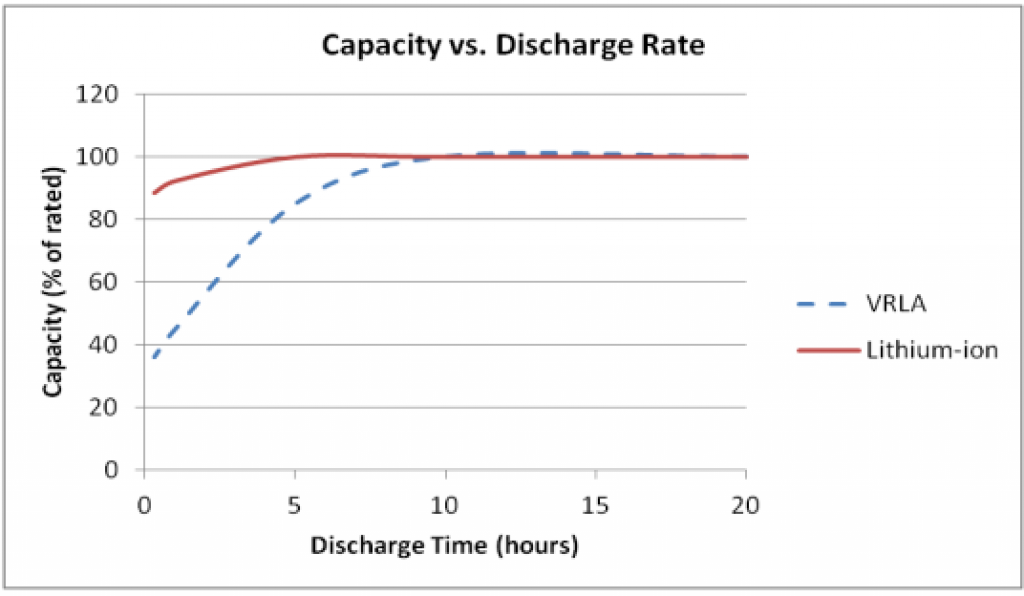
Alternatively, lithium-ion can still provide about 90 to 98 Ah when discharged fully in less than an hour. This is an important consideration if we are looking at fast-discharge applications.
Nevertheless, it is important to note that lead acid is still at par with lithium-ion if we look at applications with 8-hour discharge times or longer.
In summary, lithium-ion batteries are more efficient and less restrictive than lead acid in terms of depth of discharge, battery cycles, and discharge rate performance. These three factors are vital considerations when balancing price and performance depending on the appliances you want to connect to your 100Ah battery.
Lastly, we think you should know that we barely scratched the surface here about Lead acid vs. Lithium-Ion. We recommend this article if you want to geek out more on comparisons between Lead acid and lithium-ion.
How Long Will A Fridge Run Off A 100Ah Battery?
How long a fridge will run off a 100Ah Battery highly depends on what type of refrigerator you are talking about. If you are looking to power a refrigerator in your house that needs 110-230 V AC, there are extra steps that we should take and a lot of “what ifs” to look out for.
As shown in the figure below, you will need to purchase a full-sine wave inverter to convert DC power coming from solar panels or batteries to AC voltage.
Aside from converting DC to AC, having an inverter also converts your 12V DC into 110-230V AC at 50/60Hz.
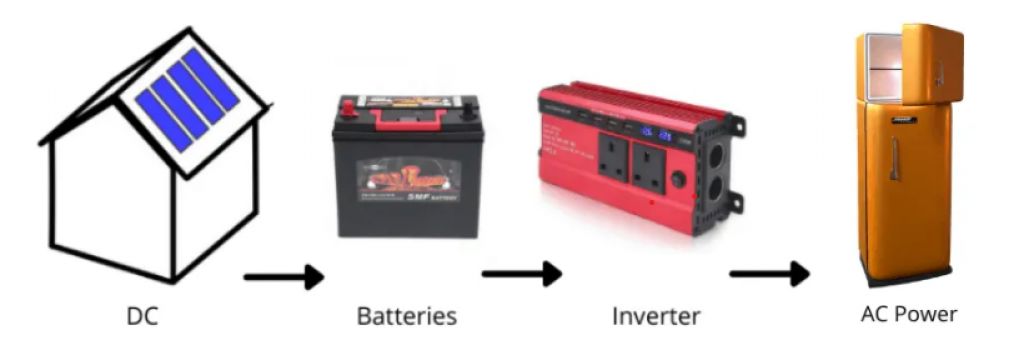
On the other hand, if you use your 100Ah battery to power a 12V DC portable refrigerator, it’s a simple plug-and-play situation.
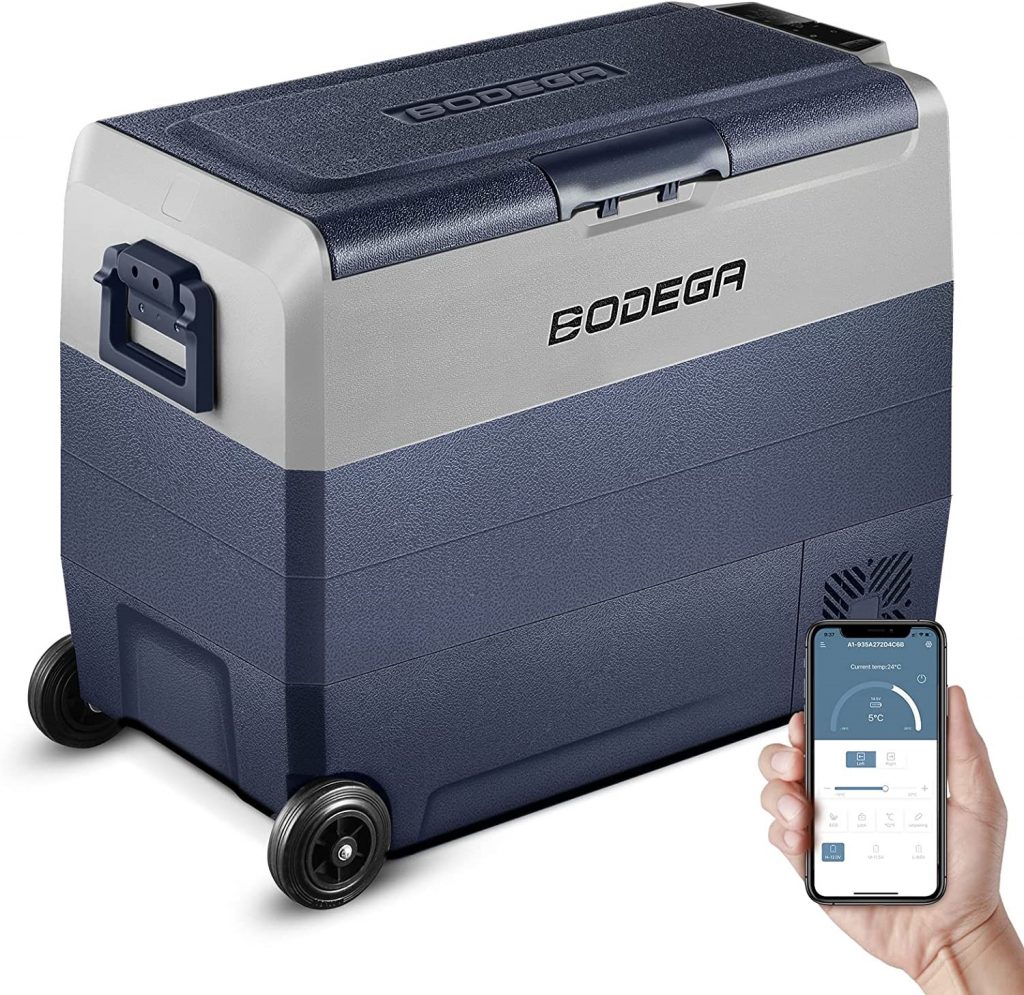
12V DC Fridge
Take this 75W, 12-volt refrigerator, for example. If it has a current rating of 6.0 Amps at 12 Volts, You can follow the table below depending on your chosen battery technology and whether you want to follow the DoD guideline or not.
| Lead Acid duration | Lithium-Ion | |
| No DoD limits | 16.66 hours | 16.66 hours |
| Following 50% DoD (lead acid) and 80% DoD (lithium-ion) rules | 8.33 hours | 13.33 hours |
If you are curious about how we got the figures above, here is the calculation process:
- For the case with no DoD limits, we divide the 100Ah battery capacity by 6.0 Amps refrigerator current rating at 12V, yielding 16.66 hours.
- At 50% DoD, you would limit your lead acid energy usage to only 50 Ah. Dividing this by 6.0 Amps yields 8.33 hours
- At 80% DoD, you would limit your lithium ion energy usage to 80 Ah. Dividing this by 6.0 Amps yields 13.33 hours
120V AC Fridge
Now, If you are looking to power a typical 400W, 115V, 3.5A refrigerator, for example, you can run the same process.
- Purchase an inverter that will convert 12V DC to 115V AC. For simplicity, we didn’t include the efficiency impact of having an inverter to your system, but it also requires energy depending on which one you purchase.
- For the case with no DoD limits, we divide the 100Ah battery capacity by 3.5 Amps refrigerator current rating at 115V, yielding 28.57 hours.
- At 50% DoD, you would limit your lead acid energy usage to only 50 Ah. Dividing this by 3.5 Amps yields 14.29 hours
- At 80% DoD, you would limit your lithium ion energy usage to 80 Ah. Dividing this by 3.5 Amps yields 22.86 hours
| Lead Acid duration | Lithium-Ion | |
| No DoD limits | 28.57 hours | 28.57 hours |
| Following 50% DoD (lead acid) and 80% DoD (lithium-ion) rules | 14.29 hours | 22.86 hours |
However, as early as now, we have to point out a big what-if here for AC applications. In reality, kitchen refrigerators require 1200W minimum during startup, which is equal to the full capacity of a 100ah battery.
Electrical engineers call this phenomenon “surge current,” which can potentially empty the 100Ah battery during startup. This challenge applies not just to refrigerators but to other AC, motor-based appliances.
That is why we cannot thoroughly recommend that you use 100Ah batteries for your motor-based home appliances. If you want to go this route, we recommend investing in a soft start kit to improve the compressor’s startup efficiency and reduce the power draw on your batteries.
How Long Will An AC Unit Run Off A 100Ah Battery?
Now, figuring out how long an AC Unit will run off a 100Ah battery is similar to our process for refrigerators.
Before we proceed, let’s clarify some abbreviations first. The expression “AC” in the AC unit refers to air-conditioning, while “AC” used in “AC power” means alternating current.
A 120V AC power air-conditioner will require an inverter to convert 12V DC power to 120 V AC power. A 600W DC window-type AC unit will last 1 hour with a lead-acid battery and 1.33 hours with a lithium-ion battery. When powering your 600W air conditioners with an inverter, expect a lower run time due to inverter energy losses.
As you can see, you would need lots of 100Ah batteries to run your AC units for a reasonable amount of time.
This is the reason why manufacturers are slowly introducing 12V AC units to the market. However, they are not on par with existing RV AC units in terms of cooling performance, so you have to study your options first before making a decision.
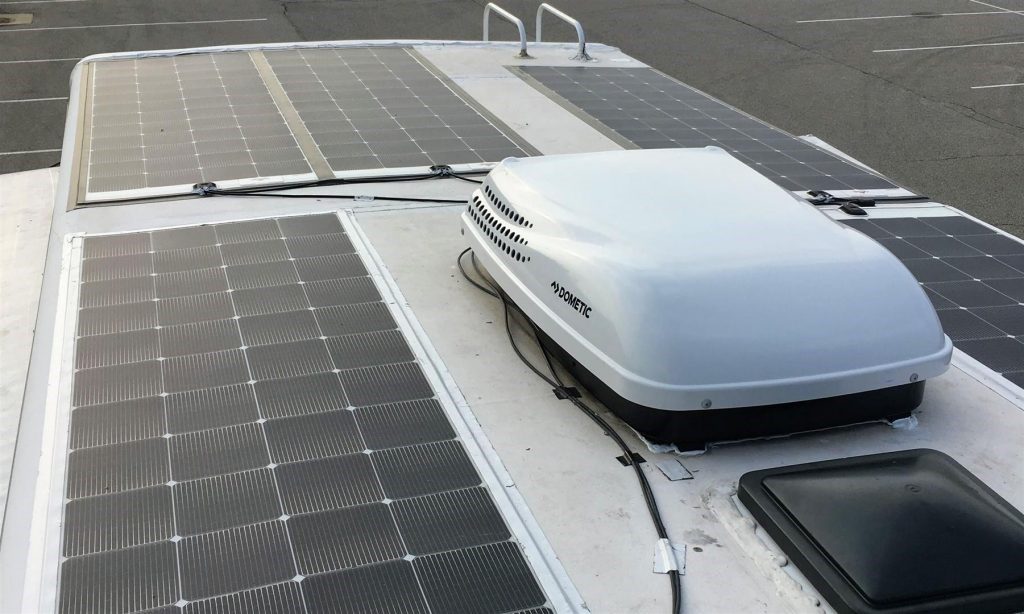
How Long Will A Playstation 5 Run Off A 100Ah Battery?

Okay, let’s see how long your PlayStation 5 would run off a 100Ah battery.
Even though the rated maximum power of a PlayStation 5 is 350 watts, the typical power consumption when you are using it for games is about 140-200 watts.
Therefore, the summary of answers is shown in the table below if you are using your PlayStation 5 for gaming:
| Lead Acid | Lithium-Ion | |
| No DoD limits | 6 to 8.57 hours | 6 to 8.57 hours |
| Following 50% DoD (lead-acid) and 80% DoD (lithium-ion) rules | 3 to 4.29 hours | 4.8 to 6.86 hours |
Connecting your PlayStation 5 to a 100Ah For a 12V DC to 120V AC inverter is required if you use 100Ah batteries as a power source.
Now, recall in the introduction earlier that we can convert 100Ah at 12V to 1200 Wh. Both are interchangeable units of electric charges.
Using the information above, we can begin computing for the PlayStation run time given as follows:
- For the case with no DoD limits, we divide the 1200 Wh battery capacity by 140 and 200 watts, yielding 8.57 and 6 hours respectively.
- At 50% DoD, you would limit your lead acid energy usage to only 600 Wh. Dividing this by 140 and 200 watts yields 4.29 and 3 hours respectively.
- At 80% DoD, you would limit your lithium ion energy usage to 960 Wh. Dividing this by 140 and 200 watts yields 6.86 and 4.8 hours respectively
How Long Will A Fan Run Off A 100Ah Battery?
Now, how long will a fan run off a 100Ah battery?
First, our typical data: Fan power ratings vary depending on the size, but most fans fall between 120 and 600 watts, according to the National Renewable Energy Laboratory.
We can get the following results using the same process as we did in the PlayStation 5 study.
| Lead Acid | Lithium-Ion | |
| No DoD limits | 2 to 10 hours | 2 to 10 hours |
| Following 50% DoD (lead-acid) and 80% DoD (lithium-ion) rules | 1 to 5 hours | 1.6 to 9 hours |
Try using the formulas yourself this time and see if you can get the same results as shown in the table. Who knows, we might have made a mistake in our calculations, and you can proudly correct our mistake in the comments section below 😉
How Long Will A Water Pump Run Off A 100Ah Battery?
How about a water pump or sump pump? How long can you run it off a 100Ah battery?
Using the same process, a typical 240-watt sump pump or water pump will yield the following results:
| Lead Acid | Lithium-Ion | |
| No DoD limits | 5 hours | 5 hours |
| Following 50% DoD (lead acid) and 80% DoD (lithium-ion) rules | 2.5 hours | 4 hours |
How Long Will A Radio Run Off A 100Ah Battery?
Well, this is a tough one since there are a lot of radios out there. You have AM/FM radios, handheld two-way radios, so on and so forth.
However, we will assume that radio uses about 5 watts of power to transmit and receive simple signals. Therefore, we get the following run times:
| Lead Acid | Lithium-Ion | |
| No DoD limits | 240 hours | 240 hours |
| Following 50% DoD (lead acid) and 80% DoD (lithium-ion) rules | 120 hours | 192 hours |
Final Thoughts
Wow, that was a lot of appliances we just went through. Congratulations!
If you finished all the way here, you probably mastered how to compute run hours for any appliance rating.
When you look at it from a broader view, you can observe that we need three things to get the run time:
- Know how much charge your battery can store (Ah or Wh)
- Know the appliance Current (ampere) or Power rating (watts)
- Divide the battery charge by the corresponding appliance rating to get the run time (hours)
We also learned that not all computations are straightforward.
- For motor-based, AC power appliances, more considerations are required;
- Do you want a 120 V AC power air-conditioned/refrigerator or a less powerful 12 V DC one? If it’s the former, an inverter is needed to properly integrate your 12V DC, 100Ah battery.
- Which battery technology will you use? Different types have varying prices, DoD, discharge rate performance and battery cycles.
Lastly, the scope of this article only covered Lead Acid and Lithium-Ion battery technology. If you are interested in the new player in battery town, we have an article that talks about Lithium iron phosphate batteries, also known as LiFePO4 or LFP.

